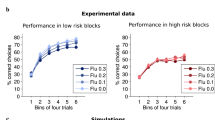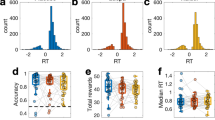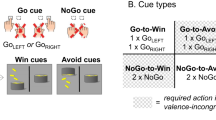Abstract
The basal ganglia support learning to exploit decisions that have yielded positive outcomes in the past. In contrast, limited evidence implicates the prefrontal cortex in the process of making strategic exploratory decisions when the magnitude of potential outcomes is unknown. Here we examine neurogenetic contributions to individual differences in these distinct aspects of motivated human behavior, using a temporal decision-making task and computational analysis. We show that two genes controlling striatal dopamine function, DARPP-32 (also called PPP1R1B) and DRD2, are associated with exploitative learning to adjust response times incrementally as a function of positive and negative decision outcomes. In contrast, a gene primarily controlling prefrontal dopamine function (COMT) is associated with a particular type of 'directed exploration', in which exploratory decisions are made in proportion to Bayesian uncertainty about whether other choices might produce outcomes that are better than the status quo. Quantitative model fits reveal that genetic factors modulate independent parameters of a reinforcement learning system.
This is a preview of subscription content, access via your institution
Access options
Subscribe to this journal
Receive 12 print issues and online access
$209.00 per year
only $17.42 per issue
Buy this article
- Purchase on Springer Link
- Instant access to full article PDF
Prices may be subject to local taxes which are calculated during checkout







Similar content being viewed by others
Change history
09 September 2009
In the version of this article initially published, the last sentence of the second new paragraph on page 1065 read “that is, the following term was added to the RT prediction: ρ[σslow(s,t) – σfast(s,t)] , where ρ is a free parameter." A variable in the equation contained in this sentence was incorrect. The sentence should read “that is, the following term was added to the RT prediction: ρ[µslow(s,t) – µfast(s,t)], where ρ is a free parameter.” The error has been corrected in the HTML and PDF versions of the article.
References
Scheres, A. & Sanfey, A.G. Individual differences in decision making: Drive and Reward Responsiveness affect strategic bargaining in economic games. Behav. Brain Funct. 2, 35 (2006).
Hsu, M., Bhatt, M., Adolphs, R., Tranel, D. & Camerer, C.F. Neural systems responding to degrees of uncertainty in human decision-making. Science 310, 1680–1683 (2005).
Frank, M.J., Woroch, B.S. & Curran, T. Error-related negativity predicts reinforcement learning and conflict biases. Neuron 47, 495–501 (2005).
Gittins, J.C. & Jones, D. A dynamic allocation index for the sequential design of experiments. in Progress in Statistics (eds. Gani, J., Sarkadi, K. & Vincze, I.), 241–266 (North Holland Publishing Company, Amsterdam, 1974).
Sutton, R.S. & Barto, A.G. Reinforcement Learning: An Introduction (MIT Press, Cambridge, Massachusetts, USA, 1998).
Daw, N.D., O'Doherty, J.P., Dayan, P., Seymour, B. & Dolan, R.J. Cortical substrates for exploratory decisions in humans. Nature 441, 876–879 (2006).
Cohen, J.D., McClure, S.M. & Yu, A.J. Should I stay or should I go? How the human brain manages the trade-off between exploitation and exploration. Phil. Trans. R. Soc. Lond. B 362, 933–942 (2007).
Depue, R.A. & Collins, P.F. Neurobiology of the structure of personality: dopamine, facilitation of incentive motivation, and extraversion. Behav. Brain Sci. 22, 491–517 (2001).
Meyer-Lindenberg, A. et al. Genetic evidence implicating DARPP-32 in human frontostriatal structure, function, and cognition. J. Clin. Invest. 117, 672–682 (2007).
Frank, M.J., Moustafa, A.A., Haughey, H.M., Curran, T. & Hutchison, K.E. Genetic triple dissociation reveals multiple roles for dopamine in reinforcement learning. Proc. Natl. Acad. Sci. USA 104, 16311–16316 (2007).
Klein, T.A. et al. Genetically determined differences in learning from errors. Science 318, 1642–1645 (2007).
Ouimet, C.C., Miller, P.E., Hemmings, H.C., Walaas, S.I. & Greengard, P. DARPP-32, a dopamine- and adenosine 3':5'-monophosphate-regulated phosphoprotein enriched in dopamine-innervated brain regions. III. Immunocytochemical localization. J. Neurosci. 4, 111–124 (1984).
Stipanovich, A. et al. A phosphatase cascade by which rewarding stimuli control nucleosomal response. Nature 453, 879–884 (2008).
Calabresi, P. et al. Dopamine and cAMP-regulated phosphoprotein 32 kDa controls both striatal long-term depression and long-term potentiation, opposing forms of synaptic plasticity. J. Neurosci. 20, 8443–8451 (2000).
Hirvonen, M. et al. Erratum: C957T polymorphism of the dopamine D2 receptor (DRD2) gene affects striatal DRD2 availability in vivo. Mol. Psychiatry . 10, 889 (2005).
Montague, P.R., Dayan, P. & Sejnowski, T.J. A framework for mesencephalic dopamine systems based on predictive Hebbian learning. J. Neurosci. 16, 1936–1947 (1996).
Frank, M.J. Dynamic dopamine modulation in the basal ganglia: a neurocomputational account of cognitive deficits in medicated and nonmedicated Parkinsonism. J. Cogn. Neurosci. 17, 51–72 (2005).
Shen, W., Flajolet, M., Greengard, P. & Surmeier, D.J. Dichotomous dopaminergic control of striatal synaptic plasticity. Science 321, 848–851 (2008).
Graybiel, A.M. Habits, rituals, and the evaluative brain. Annu. Rev. Neurosci. 31, 359–387 (2008).
Kakade, S. & Dayan, P. Dopamine: generalization and bonuses. Neural Netw. 15, 549–559 (2002).
Yoshida, W. & Ishii, S. Resolution of uncertainty in prefrontal cortex. Neuron 50, 781–789 (2006).
Frank, M.J. & Claus, E.D. Anatomy of a decision: striato-orbitofrontal interactions in reinforcement learning, decision making, and reversal. Psychol. Rev. 113, 300–326 (2006).
Roesch, M.R. & Olson, C.R. Neuronal activity related to reward value and motivation in primate frontal cortex. Science 304, 307–310 (2004).
Rudebeck, P.H., Walton, M.E., Smyth, A.N., Bannerman, D.M. & Rushworth, M.F.S. Separate neural pathways process different decision costs. Nat. Neurosci. 9, 1161–1168 (2006).
Meyer-Lindenberg, A. et al. Midbrain dopamine and prefrontal function in humans: interaction and modulation by COMT genotype. Nat. Neurosci. 8, 594–596 (2005).
Slifstein, M. et al. COMT genotype predicts cortical-limbic D1 receptor availability measured with [11C]NNC112 and PET. Mol. Psychiatry 13, 821–827 (2008).
Gogos, J.A. et al. Catechol-O-methyltransferase-deficient mice exhibit sexually dimorphic changes in catecholamine levels and behavior. Proc. Natl. Acad. Sci. USA 95, 9991–9996 (1998).
Forbes, E.E. et al. Genetic variation in components of dopamine neurotransmission impacts ventral striatal reactivity associated with impulsivity. Mol. Psychiatry 14, 60–70 (2009).
Moustafa, A.A., Cohen, M.X., Sherman, S.J. & Frank, M.J. A role for dopamine in temporal decision making and reward maximization in parkinsonism. J. Neurosci. 28, 12294–12304 (2008).
Frank, M.J., Seeberger, L.C. & O'Reilly, R.C. By carrot or by stick: cognitive reinforcement learning in parkinsonism. Science 306, 1940–1943 (2004).
Santesso, D., Evins, A., Frank, M., Cowman, E. & Pizzagalli, D. Single dose of a dopamine agonist impairs reinforcement learning in humans: evidence from event-related potentials and computational modeling of striatal-cortical function. Hum. Brain Mapp. 30, 1963–1976 (2009).
Wiecki, T.V., Riedinger, K., Meyerhofer, A., Schmidt, W.J. & Frank, M.J. A neurocomputational account of catalepsy sensitization induced by D2 receptor blockade in rats: context dependency, extinction, and renewal. Psychopharmacology (Berl.) 204, 265–277 (2009).
Bayer, H.M. & Glimcher, P.W. Midbrain dopamine neurons encode a quantitative reward prediction error signal. Neuron 47, 129–141 (2005).
O'Doherty, J. et al. Dissociable roles of ventral and dorsal striatum in instrumental conditioning. Science 304, 452–454 (2004).
O'Reilly, R.C., Frank, M.J., Hazy, T.E. & Watz, B. PVLV: the primary value and learned value Pavlovian learning algorithm. Behav. Neurosci. 121, 31–49 (2007).
Nakamura, K. & Hikosaka, O. Role of dopamine in the primate caudate nucleus in reward modulation of saccades. J. Neurosci. 26, 5360–5369 (2006).
Sutton, R.S. Integrated architectures for learning, planning and reacting based on approximating dynamic programming. Proceedings of the Seventh International Conference on Machine Learning (Porter, B.W. & Mooney, R.J., eds.) 216–224 (Morgan Kaufmann, Palo Alto, California, USA, 1990).
Dayan, P. & Sejnowski, T.J. Exploration bonuses and dual control. Mach. Learn. 25, 5–22 (1996).
Daw, N.D., Niv, Y. & Dayan, P. Uncertainty-based competition between prefrontal and dorsolateral striatal systems for behavioral control. Nat. Neurosci. 8, 1704–1711 (2005).
Niv, Y., Daw, N.D., Joel, D. & Dayan, P. Tonic dopamine: opportunity costs and the control of response vigor. Psychopharmacology (Berl.) 191, 507–520 (2007).
Dalley, J.W. et al. Time-limited modulation of appetitive Pavlovian memory by D1 and NMDA receptors in the nucleus accumbens. Proc. Natl. Acad. Sci. USA 102, 6189–6194 (2005).
Zhang, Y. et al. Polymorphisms in human dopamine D2 receptor gene affect gene expression, splicing, and neuronal activity during working memory. Proc. Natl. Acad. Sci. USA 104, 20552–20557 (2007).
Hollerman, J.R. & Schultz, W. Dopamine neurons report an error in the temporal prediction of reward during learning. Nat. Neurosci. 1, 304–309 (1998).
Satoh, T., Nakai, S., Sato, T. & Kimura, M. Correlated coding of motivation and outcome of decision by dopamine neurons. J. Neurosci. 23, 9913–9923 (2003).
Bayer, H.M., Lau, B. & Glimcher, P.W. Statistics of midbrain dopamine neuron spike trains in the awake primate. J. Neurophysiol. 98, 1428–1439 (2007).
Dalley, J.W. et al. Nucleus accumbens D2/3 receptors predict trait impulsivity and cocaine reinforcement. Science 315, 1267–1270 (2007).
Belin, D., Mar, A.C., Dalley, J.W., Robbins, T.W. & Everitt, B.J. High impulsivity predicts the switch to compulsive cocaine-taking. Science 320, 1352–1355 (2008).
Zemel, R.S., Dayan, P. & Pouget, A. Probabilistic interpretation of population codes. Neural Comput. 10, 403–430 (1998).
Ma, W.J., Beck, J.M., Latham, P.E. & Pouget, A. Bayesian inference with probabilistic population codes. Nat. Neurosci. 9, 1432–1438 (2006).
Ye, S., Dhillon, S., Ke, X., Collins, A.R. & Day, I.N. An efficient procedure for genotyping single nucleotide polymorphisms. Nucleic Acids Res. 29, e88-1–e88–8 (2001).
Acknowledgements
We thank S. Williamson and E. Carter for help with DNA analysis and administering cognitive tasks to participants, and N. Daw, P. Dayan, and R. O'Reilly for helpful discussions. This research was supported by US National Institutes of Mental Health grant R01 MH080066-01.
Author information
Authors and Affiliations
Contributions
M.J.F., B.B.D. and F.M. designed the study; M.J.F. conducted the modeling and analyzed the behavioral data; B.B.D. collected data; J.O.-T. and F.M. extracted the DNA and conducted genotyping; M.J.F., B.B.D. and F.M. wrote the manuscript.
Corresponding author
Supplementary information
Supplementary Text and Figures
Supplementary Data Analysis (PDF 862 kb)
Supplementary Video 1
Single subject evolution of beta distributions, DEV. (MPG 1444 kb)
Supplementary Video 2
Single subject evolution of beta distributions, CEV. (MPG 1467 kb)
Rights and permissions
About this article
Cite this article
Frank, M., Doll, B., Oas-Terpstra, J. et al. Prefrontal and striatal dopaminergic genes predict individual differences in exploration and exploitation. Nat Neurosci 12, 1062–1068 (2009). https://doi.org/10.1038/nn.2342
Received:
Accepted:
Published:
Issue Date:
DOI: https://doi.org/10.1038/nn.2342
This article is cited by
-
Secondary outcomes and qualitative findings of an open-label feasibility trial of lisdexamfetamine dimesylate for adults with bulimia nervosa
Journal of Eating Disorders (2023)
-
PET-measured human dopamine synthesis capacity and receptor availability predict trading rewards and time-costs during foraging
Nature Communications (2023)
-
Exploratory preferences explain the human fascination for imaginary worlds in fictional stories
Scientific Reports (2023)
-
Disentangling the roles of dopamine and noradrenaline in the exploration-exploitation tradeoff during human decision-making
Neuropsychopharmacology (2023)
-
Impulsivity and risk-seeking as Bayesian inference under dopaminergic control
Neuropsychopharmacology (2022)



